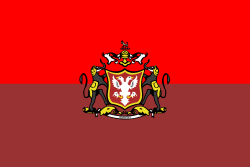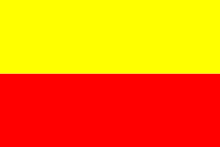Flag of Karnataka
At present there is no official de jure flag of Karnataka, a state in India. A flag was proposed for the state in 2018, but was subsequently withdrawn and the unofficial Kannada flag remains in popular use in the state.
Flag of the Kingdom of Mysore (1399–1974)

The present-day Karnataka state went through a series of geopolitical and cultural transformations. After India's independence in 1947, the constitutional changes took nearly three years to come into effect, during when Kingdom of Mysore remained the state's original form territorially. In 1950, the Kingdom of Mysore was renamed Mysore State when India became a democratic republic, but Maharaja Jayachamarajendra Wadiyar continued to be the chief head of Mysore State (as maharaja, then as rajpramukh, and finally as governor). In 1956, the Reorganisation of States Act on linguistic-basis was passed by the Republic of India, which furthered Mysore State's frontiers. Coastal parts of Mangalore, which previously belonged to Madras Presidency, were incorporated into Mysore State, as well as Kannada-speaking regions of Bombay Presidency (sometimes referred to as Bombay-Karnataka region) and Hyderabad State (Hyderabad-Karnataka region). In 1974, Mysore State was renamed Karnataka State. Until this point, the flag of the Kingdom of Mysore remained the state's flag, official until 1956, and de facto thereafter, until 1974, alongside the bi-coloured Kannada flag. With the renaming of state, pro-Kannada movements throughout Karnataka gained pace, during when the bi-coloured Kannada flag became more prevalent.
The Mysore Kingdom flag was oblong and bi-coloured: a red strip on the top, symbolising vermilion, and a maroon strip on the bottom. In the centre was inscribed the coat of arms of the Kingdom of Mysore. Some synonymous versions of the flag redact the emblem; the original version, however, comes with it inscribed in the centre. The coat of the arms bears a mythical two-headed eagle, called Gandabherunda, in Kannada. This emblem itself was an adoption from that of the Vijayanagara Empire. Mysore Kingdom inherited this right after the principality was commissioned in 1399 by Harihara II, anointing Mysore Kingdom's first ruler, Yaduraya Wodeyar, as its ruler.
After the state's renaming in 1974, this flag was gradually decommissioned. Nevertheless, this flag remains, to this day, the official flag of the Mysore royal family, and is used during the private and, sometimes, in public, celebrations of the Dasara festival, including the Special Assembly (khas durbar) during the carnival.
Kannada flag

While the bi-coloured Kannada flag remained the state's de facto flag, the legal complications were quite complex. The bi-coloured flag is the official flag of a state political party called Kannada Paksha. It would be an advertisement of the party if the state recognised this flag as its own official one. However, the flag itself was designed and became prevalent during pro-Kannada movements in the late 1960s. Therefore, the bi-coloured flag became more sentimentally attached to the people and Kannada speakers and literati.
When in 2018, Chief Minister Siddaramaiah's government officially recognised the latest version, the party leader Vatal Nagaraj expressed his disapproval.[1]
The Kannada flag is a flag that is in popular use in the state of Karnataka, India. It is widely identified with Karnataka, ಕನ್ನಡಿಗ and the Kannada language. The flag does not represent separatist ideology and was used across the length and breadth of the state by Kannada-centric organizations and private individuals to show solidarity with Kannada causes and demonstrate their unity.[2] It finds a place in the official website of the Government of Karnataka.[3]
History
The flag was first conceived by Ma Ramamurthy, a Bangalore-based writer, journalist and social activist, often considered as a commander of Kannada movement in 1960s.[4] Ma Ramamurthy was the son of noted freedom fighter and litterateur, Veerakesari Seetharama Shastri. The 1963 Tamil movie Kaanchi Thalaivan featured a scene where the Tamil king tramples upon the flag of the Chalukyas. This infuriated the Kannada activists who staged massive protests under the leadership of Ma. Ramamurthy. [5] In the aftermath of Kaanchi Thalaivan episode, Ma. Ramamurthy went on a padayatra in 1964, protesting against the hoisting of political flags in Bangalore by the migrant groups from the neighboring state Tamil Nadu who had brought their state poltics culture with them. He then realized the need for a flag representing Karnataka and designed a yellow flag depicting Karnataka map with a paddy crown in the center which was simplified later to its current form.[6] He used the flag for the political party called Kannada Paksha which he founded in 1965. The political party is active now the flag has been consistently used all over Karnataka to represent the state, Kannada language and culture. This flag is prominently hoisted on the occasion of Karnataka Rajyotsava celebrated on 1 November as the state's Formation Day. It is routine in many educational and government institutions. After hoisting the flag, the official State anthem written in Kannada, Jaya Bharata Jananiya Tanujate is sung.[7] One can find the yellow-red flag fluttering atop buildings, flag posts at road junctions, and on vehicles along the length and breadth of Karnataka State. Many institutions host the flag to protect their buildings from local agitations.
In several pro-Kannada movements including Gokak agitation the flag has been used as the symbol of the unity of Kannadigas. In 1998, Kannada Development Authority recommended for granting it state flag status but the state law department cited legal hurdles for the same.[8]
In 2009, B. S. Yeddyurappa, then Chief Minister of Karnataka, issued a circular enforcing restrictions on hoisting Kannada flag on government buildings.[9] Later, this move was challenged in Karnataka High Court in 2012 after then Chief Minister D. V. Sadananda Gowda mentioned in his budget speech that the hoisting of the Kannada flag on 1 November will be made compulsory in all government offices, schools and colleges. During hearing, a division bench of the high court headed by Chief Justice Vikramajit Sen questioned the government's move to hoist "any flag" other than the national flag. The court had also sought a response from the government regarding "whether it is possible for the State to have any flag other than the national flag" while also asking the Union government to clarify the law in this connection.[10] Subsequently, the state Govt decided to withdraw its circular before the eve of Rajyotsava in 2012.
Abandoned 2018 flag proposal
A delegation from the noted Kannada writer and journalist Patil Puttappa, and Bheemappa Gundappa Gadada, a social worker, met him, Chief Minister Siddaramaiah constituted in June 2017 a panel of nine legal experts, scholars, and Kannada literati, headed by G. S. Siddaramaya, Principal Secretary of the Department of Kannada and Culture, to study the legality and judicial implications of the formal adoption of a flag for the state.[11]
After the committee submitted a report, a team of designers was instituted, which came up with the latest version that is now in effect.[12] The current version is a symbolic confluence of the National flag of India—with tri-colour strips—and the old Karnataka flag, as well as the Emblem of Karnataka charged in the centre of the flag, which, in majority, is a derivation of the coat of arms of the Kingdom of Mysore.[13] The design was met with opposition from pro-Kannada political parties and groups, arguing that the old Kannada flag was more representative of the state than the new one.[1]
The 2018 flag was proposed by Chief Minister Siddaramaiah who unveiled it on 8 March 2018. In August 2019, the Government of Karnataka announced it was no longer officially pursuing the proposal for a separate state flag. [14]
Government banner
The Government of Karnataka can be represented by a banner that depicts the emblem of the state on a white background.
.png) Banner of Karnataka
Banner of Karnataka
See also
References
- "Cannot Accept Proposed Karnataka Flag Design, Says Pro-Kannada Group Leader". News18.com. Retrieved 8 March 2018.
- "Rajyotsava celebrated without usual fanfare". The Hindu. 2 November 2007. Retrieved 11 January 2020.
- "Pages - kannada". Karnataka.gov.in. 22 December 2015. Archived from the original on 9 December 2016. Retrieved 1 December 2016.
- "KarnatakaHistory: Ma.Ramamurthy, the Creator of Kannada flag". Karnatakahistory.blogspot.in. Retrieved 1 December 2016.
- https://medium.com/@hs.raghavendra/a-short-story-of-the-kannada-flag-b8a42e2cc1f0
- "Decoding Kannada flag". Bangalore Mirror. 2 November 2012. Retrieved 1 December 2016.
- Karnataka Rajyotsava
- "Can anyone fly a flag other than tricolour? - Times of India". Timesofindia.indiatimes.com. 23 March 2012. Retrieved 1 December 2016.
- "Kannada flag: circular to be withdrawn". The Hindu. Retrieved 1 December 2016.
- "Panel Recommends Separate Flag For Karnataka". Ndtv.com. Retrieved 8 March 2018.
- "Karnataka panel proposes 3-colour official state flag". The Indian Express. 8 February 2018. Retrieved 8 March 2018.
- Shankar, Shiva (7 February 2016). "State flag may be a tricolour with Karnataka emblem on white". The Times of India. Retrieved 11 January 2020.
- https://www.thenewsminute.com/article/karnataka-govt-will-not-pursue-demand-separate-state-flag-minister-ct-ravi-108102